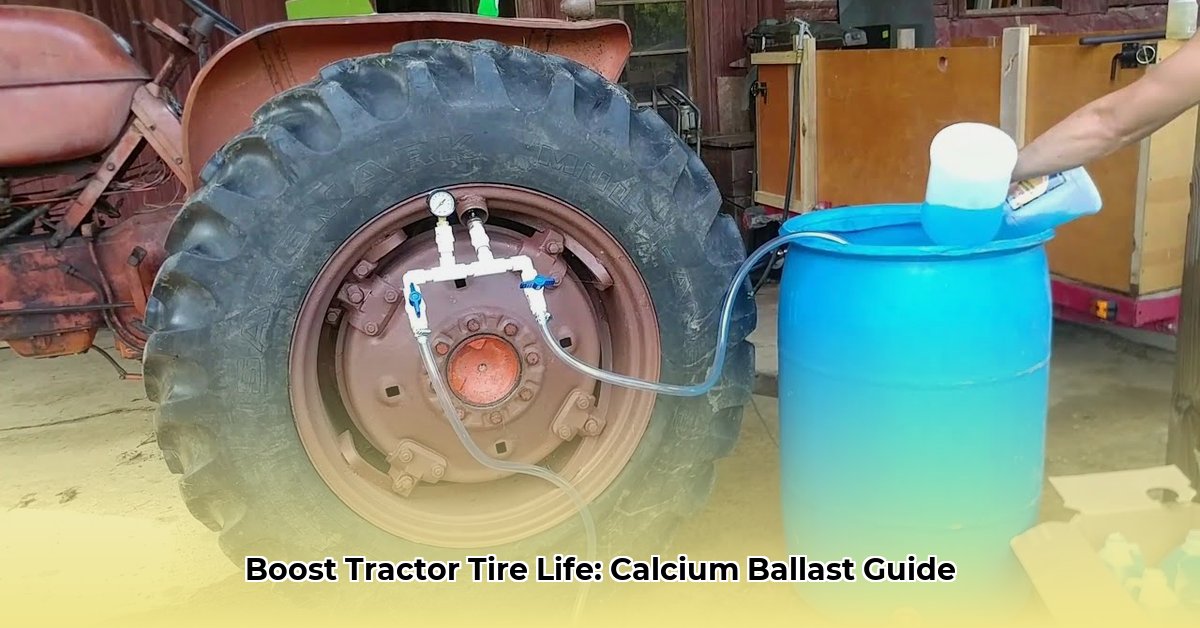
Choosing the right liquid ballast for your tractor tires is crucial for optimal traction, stability, and tire longevity. This guide will help you navigate the various options, considering factors like cost, environmental impact, freeze resistance, and corrosiveness. We'll provide a step-by-step process to guide your decision, ensuring you select the best ballast for your specific needs and operating conditions. For more in-depth tractor tire information, check out this helpful resource.
Weighing Your Ballast Options: A Comparative Analysis
Several liquid ballast options exist, each with unique pros and cons. Let's delve into a detailed comparison:
Water
- Pros: Inexpensive and readily available.
- Cons: Freezes at 32°F (0°C), resulting in immobility and potential tire damage in colder climates. Low density requires larger volumes for effective ballasting.
Antifreeze (Ethylene Glycol)
- Pros: Very low freezing point, maintaining fluidity even in sub-zero temperatures.
- Cons: Extremely toxic, posing significant environmental and health risks. Requires stringent safety protocols during handling and disposal. Expensive compared to other options.
Antifreeze (Propylene Glycol)
- Pros: Less toxic than ethylene glycol, offering a lower freezing point.
- Cons: More expensive than water or calcium chloride. Still carries some environmental concerns and requires careful handling.
Calcium Chloride
- Pros: Inexpensive and possesses a low freezing point, making it suitable for colder climates.
- Cons: Highly corrosive, potentially damaging tires and rims over time. Requires careful handling and proper disposal to avoid environmental issues.
Beet Juice
- Pros: Biodegradable, non-toxic, and environmentally friendly. Possesses a reasonably low freezing point.
- Cons: Most expensive option. Sourcing can be challenging depending on location and availability.
Windshield Washer Fluid
- Pros: Readily available and offers a low freezing point.
- Cons: Highly toxic and poses significant environmental and health hazards. Should be avoided as a ballast option.
Choosing the Right Ballast: A Step-by-Step Guide
Selecting the ideal ballast involves a multi-step process, considering your specific circumstances:
Step 1: Climate Assessment: Do you experience freezing temperatures? If so, water and some other options are immediately unsuitable.
Step 2: Budgetary Considerations: Calcium chloride offers the lowest initial cost, but long-term corrosion damage could negate these savings. Beet juice represents the highest upfront investment.
Step 3: Environmental Impact: Prioritize environmentally friendly options like beet juice or propylene glycol antifreeze if minimizing environmental impact is crucial.
Step 4: Risk Tolerance: Are you willing to accept the risk of corrosion with calcium chloride to save money initially? Or, is minimizing environmental and health risks a higher priority?
Step 5: Regulatory Compliance: Check local regulations on handling and disposing of hazardous materials.
Safety Precautions and Regulations
Always adhere to manufacturer instructions and local regulations for handling, storage, and disposal of liquid ballast. Protective gear (gloves, eye protection) is essential, especially when dealing with corrosive or toxic substances. Proper disposal prevents environmental contamination.
Long-Term Considerations: Maintenance and Replacement
Initial costs are only part of the equation. Corrosion from calcium chloride can lead to premature tire and rim failure, resulting in unexpected and costly replacements. Regular inspections are crucial for extending the lifespan of your tires and rims.
Ballast Options Compared: Summary Table
| Ballast Type | Cost | Freezing Point | Toxicity | Corrosiveness | Environmental Impact |
|---|---|---|---|---|---|
| Water | Very Low | High | Very Low | Low | Low |
| Antifreeze (Ethylene) | Moderate | Very Low | Very High | Low | High |
| Antifreeze (Propylene) | Moderate | Very Low | Moderate | Low | Moderate |
| Calcium Chloride | Very Low | Very Low | Low | High | Moderate |
| Beet Juice | High | Low | Very Low | Low | Very Low |
| Windshield Washer Fluid | Low | Very Low | Very High | Low | High |
Conclusion: Making the Right Choice
The optimal liquid ballast depends on your unique needs and priorities. This guide provides a framework for making an informed decision, balancing cost, environmental impact, and operational requirements. Remember, safety and responsible environmental practices should always be paramount.
Resources
(Add links to relevant websites, research papers, and regulatory bodies here)